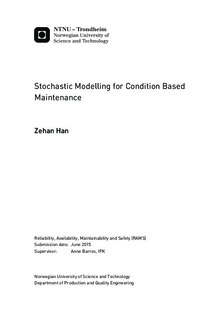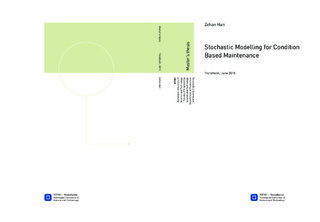| dc.description.abstract | This Master's thesis covers almost all aspects of Condition Based Maintenance (CBM). All objectives in Chapter 1 are met. The thesis is mainly comprised of three parts. First part introduces the world of CBM to readers. This part presents data acquisition, data processing and databases, which are the foundation to CBM. Then it highlights models which are divided into physics based models, data-driven models and hybrid models, for diagnostic and prognostic use. Three promising diagnostic and prognostic models are specified, i.e., Markov model, Artificial neural networks and the time-dependent proportional hazard model. Afterwards, CBM main steps are presented in figure 2.2. This figure is made based on a large quantity of literature review and can function as an index when readers are querying CBM data, diagnostic and prognostic models and steps. It can also give readers a whole picture of CBM. Next, introductions of Prognostic and Health Management (PHM), CBM industry applications and CBM state of the art are followed. Specific challenges, phenomena and questions are summarized.
Second part presents a Matlab toolbox made by the writer. This toolbox estimates components' Remaining Useful Life (RUL) with a standard deviation, the probability to survive till the next maintenance time and Probability of Failure on Demand (PFD) based on numerous simulations. The stochastic processes behind are the (continuous time) Markov model, the Brownian motion process and the Gamma process. Users can choose among them in the toolbox. Specially, MTTF and the steady-state-probability can be achieved by using the Markov model. This toolbox is used often in the next part when data is analyzed. The writer makes the graphic interface of this toolbox easy for people to use. All instructions are given. All code is also attached, from the whole toolbox code to a tiny simulation step with detailed explanations. This toolbox makes it possible for the people with little knowledge in statistics and maintenance to make their own maintenance plans. This toolbox can be download on-line.
The third part of this Master's thesis uses 7 statistic models and 3 stochastic processes to model the degradation process of the elastomeric annular body from the annular preventer of a BOP system. To make these models, many relevant papers and books are studied. In this Master's thesis, these models are not just "theories" or "formulas". Instead, for each model, the writer gives a vivid example by analyzing the data with all Matlab code and detailed explanations following. The writer believe by doing this readers can have a deeper understanding of each model. They may use one of these models for their own data in the future. To make it easier for readers to follow, the difficulty of these models is increasing one after one. The complex model can give a more precise estimation of the lifetime with more influence factors being taken into consideration. As to the structure of the third part, firstly, much literature about BOP is read. A brief description about BOP systems is followed. Virtual failure data is simulated based on a trustful BOP reliability report. The exponential model is firstly used to give a preliminary understanding of the data. Afterwards, the Weibull model, the log-logistic model and the log-normal model are used. All these models use Maximum likelihood Estimation (MLE). Minitab is the analyzing software used here. Then, the Brownian motion process is introduced to model the degradation process. Next, the covariates are introduced (e.g., the temperature). The Weibull regression model is elaborated followed by Proportional hazard model (Cox regression model) and Arrhenius model. These three are very promising models used in CBM. Brownian motion is used again to model the degradation. However, this time, the covariates are taken into account. It leads to the change of the path of the Brownian motion process each time when covariates are changing. It is more complex but more realistic. This is the final step to model the degradation in a component level. To model the degradation in a system level, two extra models are included. That is the Markov model and the Brownian motion process for a koon system with covariates. They are shown in the same chapter. Finally, relevant maintenance plans are made based on the result of "RUL" and "the probability to survive till the next maintenance interval. | |

